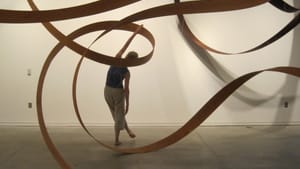Stay in the Loop
BSR publishes on a weekly schedule, with an email newsletter every Wednesday and Thursday morning. There’s no paywall, and subscribing is always free.
Site-specific dance: transformative for all ages
Fringe Festival: Leah Stein’s ‘Splice’

Site-specific performance is itself an art genre that requires an intuitive connection to a space other than the usual theater-presenting venue. It also, as recounted in a recent Brooklyn Rail piece on “Site-Specific Dance“ by Stormey Budwig, involves the intuitive gifts of the performance artist brought into that space.
Site-specific first got popularized by the sculpture and environmental California artist Robert Irwin in the 1970s as part of a movement to reimagine sculpture and the visual arts outside their historic homes of museums and art galleries. Postmodern choreographers of the Judson Memorial Church group in the early ‘60s and others into the ‘70s also experimented with many aspects of site-specific art-making, such as audience perspective and engagement, the materials of the found environment, and ambient sound.
The museum world is belatedly discovering this last half century of postmodern, contemporary dance, as institutions from MOMA to the Whitney to our own Philadelphia Museum of Art play catch-up in presenting contemporary dance — but rarely with the imagination to render it artfully site-specific within or around their institutions.
A convergence in “Convergence”
The Leah Stein Dance Company’s recent FringeArts work, Splice, was one of the most satisfying and inspired convergences of a contemporary dance performance within an art institution, in this case the recently built Leonard Pearlstein Gallery at the Westphal College of Media Arts & Design at Drexel University. Installation artist Jeremy Holmes installed his debut Philadelphia exhibition within the 3,000-square-foot gallery’s high ceilings and sliding walls. The installation, a captivating continuous ribbon of bent wood, is made out of five varieties of North American hardwoods that was itself site-specific to this vast space. (The exhibition, “Convergence,” is on through September 28.)
Holmes’s alchemy transformed these hardwoods into fluid rivers of lyrical loops and meandering streams that filled the interstices of the gallery space, sometimes otherwise unobserved by the viewer. The wood forms still left voids for a human presence and the imagination. With their slightly different color variations, these forms provided a contrast and tension with the rectangular angles of the gallery and its mechanical appendages.
Leah Stein has made a reputation over two decades as a site-specific choreographer, often choosing parks, gardens, river banks, and even a cemetery as her sites. She no doubt found the Holmes installation an ideal environment that joined elements of the natural world within a constructed interior space. She and her outstanding core group of dancers (Jungwoong Kim, David Konyk, and Michele Tantoco) interacted with the loops, jumping through them or running a maze around them, and offered stillnesses within the installation’s languorous repose by standing, crouching, or resting supine in relation to the wood.
The dancers’ linear and curvilinear movements maintained an intriguing dialogue with the looping curves of the installation, with the audience seated within and around the edges of the space. The dancers’ slicing gestures mirrored the bent wood cutting through the space as the sharp linearity of hands and arms also confronted the curving loops with an aggressive retort.
Structured improvisation
Stein’s choreography of structured improvisation allowed certain movement phrases and gestures to be clearly visible — remarkably so, as when dancers lying on the floor, separated by wide spaces of the gallery, folded their bodies, rolled backward, and ended on their sides. The choreographed sections revealed synchronicity without absolute unison, and the varieties of timing and of execution of the four dancers across the large space was exciting to capture.
Seeing the work twice brought out the improvisatory inventions of this company, who are always present and aware of the possibilities that their dance environment and fellow dancers offer, without imposing a virtuosity of movement choices into the work. Among the delightful surprises was Jungwoong Kim, who again showing his comic brilliance, in one section burst onto the floor on rollerblades.
Splice’s soundscape enhanced this performance, providing one of Stein’s most sophisticated uses of sound, perhaps influenced by the company’s recent investigations of voice and movement and the Deep Listening practice of Pauline Oliveros. In the beginning of the work, the dancers offered intermittent, ambiguous clicks, hisses, and whispers. These required us to try to identify their source, subtly introduced the dancers to us, and heightened our senses of both listening and seeing within the installation.
Sonic mysteries
Later, the dancers again intermittently offered up words that referenced different trees. The looping wood then became a sound source as the audience was encouraged to stand and lean their ears into the wood. As the dancers tapped or scratched on the looping wood, we all heard deep, rumbling sounds that communicated new sonic mysteries. And with the technical recording assistance of Peter Price, we then heard a stream of prerecorded sound that was generated by the wood through small hidden speakers attached to the wood; the first tapping sounds conjured subterranean woodpeckers signaling us from the deep, and later the sounds became more dense and industrial, also alien but familiar, and accompanied by fuller dancing.
Site-specific performances are unique in that the audience member can continue the experience after the work’s seeming end. Stirring site-specific works like Splice offer this potential precisely because the audience has been so present within the installation and the dance performance. This is different than the usual experience of being in audience seats at the fourth wall and exiting up aisles into lobbies and sidewalks.
At the close of the first performance I saw, I walked through the installation alone feeling that I was moving through wind currents, the atmosphere of the space energized by the movement of the dancers and the rhythmic rivers of bent wood. After the second performance, I gave the green light to my two grandchildren, Amelia, 6, and Isabel, 4, who ran, jumped, and caroused through the installation. Yes, postmodern performance and art, especially of the site-specific kind, can be child-friendly.
For a review of Jeremy Holmes’s installation, “Convergence,” click here.
What, When, Where
Splice, Leah Stein Dance Company, Fringe Festival, September 18-21, 2014, Leonard Pearlstein Galley of the Westphal College of Media Arts & Design, Drexel University, 3401 Filbert Street, Philadelphia. www.leahsteindanceco.org
Sign up for our newsletter
All of the week's new articles, all in one place. Sign up for the free weekly BSR newsletters, and don't miss a conversation.

 Jonathan M. Stein
Jonathan M. Stein